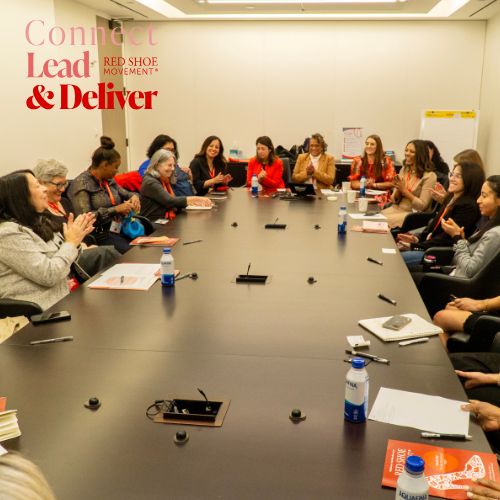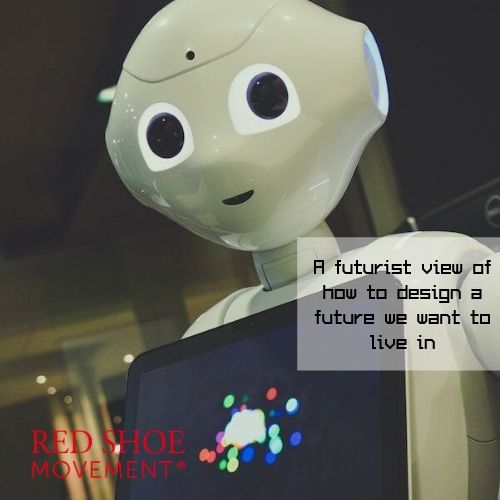Lateral thinking has two functions: to generate creative ideas and to solve problems. The more we exercise it, the more and better solutions we find to all sorts of challenges. Don’t miss this mind bending post!
What is lateral thinking?
“There are six eggs in one basket. There are six people. Each one takes an egg. How is it possible that in the end there is still an egg in the basket? ”
(Answer: The last person was left with the basket with an egg.)
This is a typical challenge that requires the use of lateral thinking. Why? Because more than data or logical reasoning, this problem demands mental processes related to insight, creativity and ingenuity.
Family, education and culture stimulate memory and vertical thinking, based on logic, which is a necessary but insufficient skill. We have two cerebral hemispheres, each specialized in one type of processing: the left is rational and the right is creative. We need to develop both sides and integrate them to be more effective in solving problems.
To incorporate lateral thinking into your life you simply practice specific creative techniques that allow you to use it at will. It’s like going to the gym, but in this case, to keep your mind in shape.
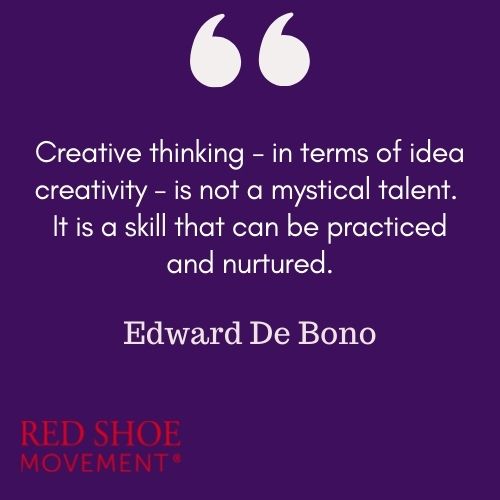
Two styles of thinking: vertical and lateral
The term lateral thinking was coined by Edward de Bono in the 1960s to differentiate it from conventional or vertical thinking, the type of thinking based on experiences, assumptions, and deductions. Using memory and vertical thinking means applying a higher dose of the same solution to a problem. In other words, they lead us to dig deeper into the same well.
Instead, with lateral thinking we dig a well in another place. And if it doesn’t work, we try another, or instead of a well we dig a tunnel, or rethink the basic approach. Because in addition to a type of mental processing, lateral thinking is a method for using information that considers that there are always several possibilities to approach a situation. Different from vertical thinking which assumes there’s only one correct way.
The aim of lateral thinking is not to come up with correct ideas, but to generate a great number of them. Then, at a later stage, you can apply vertical thinking to analyze the ideas you came up with, improve them, discard the invalid ones, choose the best ones and test them.
Want to develop this type of skills? Join our Step Up Plus program!
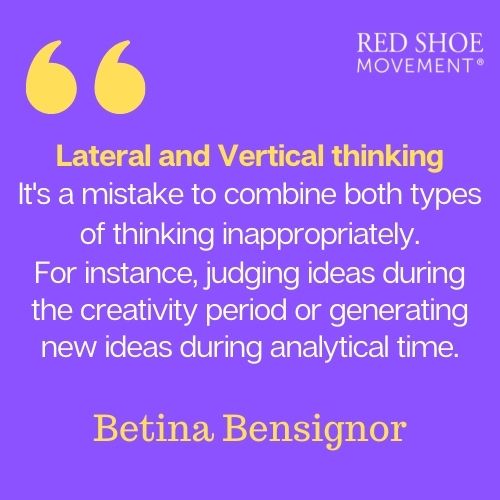
The 3 types of problems
You could define a problem as the difference between what you have and what you want to have.
By breaking down established models, lateral thinking liberates the information these models contain challenging assumptions and prejudices. This facilitates the creation of new models and mental structures, connections and processing styles. Not in a fixed way, but rather so that they can be decomposed as often as necessary.
According to Edward De Bono there are three types of problems:
1 Those that require more information. They are solved by vertical thinking, such as mathematical problems and police puzzles, which involve a logical sequence that increases with new data. Its a linear approach to a single possible solution.
2Those that do not require more information, but a reorganization or restructure of the available information. They are resolved through the use we make of data, new associations or connections, imagination and even questioning our vertical thinking. These problems are usually are based on a new perspective, a new mental process, a discovery or a series of partial ideas that bring us closer to the best solution.
This is the case of the classic lateral thinking conundrum: a gardener is instructed to plant 4 trees so that they are all equidistant. How can you plant them?
I won’t post the answer here to help you force your methods of rearranging the data I gave you. If you want to know the answer you can send me a note: bbensignor@gmail.com.
3Those that are not recognized as a problem. They have to do with perception and can’t be resolved until they are detected. They may also require a change of perspective, as in the previous case. Here we don’t even realize that we have a problem to solve. In this case, you need an increase of focus and sensitivity to the unexpected in order to perceive what you don’t know.

Impossible cube
Most people see a cube in this image of Escher. But it is a virtual figure: the front and back edges intersect. It is an example of a problem that goes unnoticed.

5 techniques to develop creativity
Lateral thinking can be trained by practicing specific techniques to develop your creativity.
Some of them are:
1Search for alternatives
An example: how can a square be divided into four equal parts? (Take a few seconds before viewing the following pictures.)
Solution: alternatives, from the easiest to the less usual:


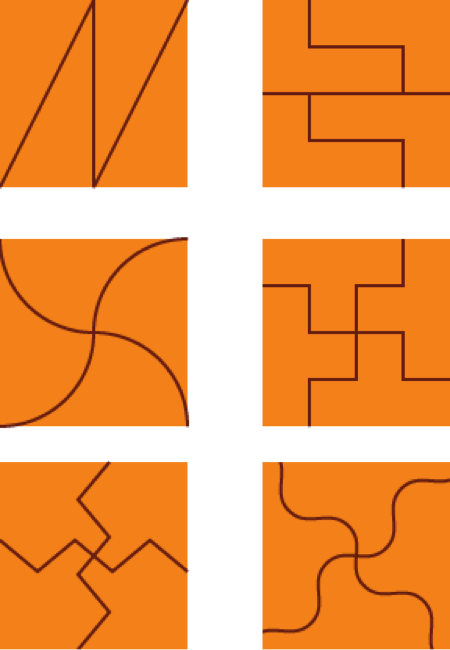
2Assumptions review: lateral thinking does not accept or reject the validity of assumptions about a topic, its objective is to question and restructure them as often as necessary.
An example: two players, O and X, mark the spaces of a 3 × 3 board alternately. A player wins if he manages to have a line of three of his symbols: the line can be horizontal, vertical or diagonal. (Take a few seconds before you see the next image.)
Solution:
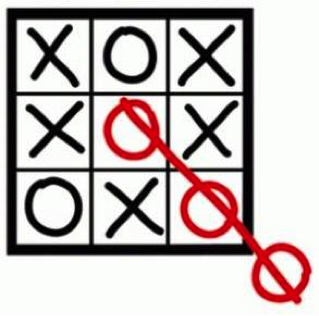
Surely, the first thing you thought about was that I cheated. I would have done it if I had explained that it was the Tic Tac Toe game. That is your assumption: at no time did I clarify that it was the traditional game and that therefore the limits of the board should not be exceeded.
3Redefining the dominant idea: a dominant idea is the theme or principle around which a situation or problem revolves. If it is not grasped, it will influence the thinking that will limit possible solutions. It is easier to escape the influence of something that is known than that which is ignored.
An example: a man lives on the 10th floor of a building. Every day he takes the elevator to the seventh floor and then climbs up the stairs the remaining three floors to his apartment on the tenth. Why does he do this? (Take a few seconds before reading the solution.)
Solution: he was little person.
The dominant idea of this riddle, as in most, is that it is a person of a standard height. And it is that idea what limits the possibility of resolution.

4Dividing technique: if a situation is divided into parts that constitute it, it is possible to restructure the situation by reordering the parts. It is important not try to find preexisting elements, but to create parts, breaking up the situation in an artificial way. This also facilitates the generation of new models, applicable to future (not necessarily similar) situations.
An example: if we are trying to solve the problem of “transportation by bus”, we could divide the situation as follows:
- Selection of itineraries
- Frequency of services
- Comfort of the service
- Total probable number of travelers
- Probable number of travelers at different times of day
- Bus capacity
- Other means of transportation
- Cost and income
- Number of travelers who depend mainly on the bus service and number of them who can easily use other forms of transportation
5Inversion method: this technique is more lateral in nature than the previous one. The problem is considered in its real structure and is inverted in one direction or another, from top to bottom, from outside to inside, causing a forced rearrangement of information.
Example: In the famous fable of Aesop, the water in the vessel was too deep for the bird to drink. The bird began to imagine means of extracting the water from the jar, without reaching any satisfactory solution. Then she reversed the focus of the problem and instead of thinking about the means of drawing water, she thought she could introduce elements into the vessel to bring the water up. In fact, she began to throw stones until she was able to drink.

Want to play and practice your lateral thinking?
Here are 3 classic riddles of lateral thinking. With this exercise you can start your training. Go ahead!
1Two chess players. Two excellent chess players played five games in one day, and each of them won three. How is that possible?
2Coal, carrot and cap. Five pieces of charcoal, a whole carrot and an elegant cap are thrown in the garden. Nobody has lost them and they’ve been in the grass for the same amount of time. How did they get there?
3You are driving your car on a terrible storm night. You pass by a bus stop where three people are waiting:
- An old woman who seems about to die.
- An old friend who saved your life once.
- The perfect man or the woman of your dreams.
Who would you take in the car, since you only have room for one passenger?
Solutions:
Answer 1: They did not play with each other, but against other opponents.
Answer 2: They are the remains of a melted snowman.
Answer 3: Unlike the previous ones, this is an ethical-moral dilemma that was once used in a job interview. You could take the old lady, because she’s going to die and therefore you should save her first. Or you could take your friend, since he saved your life and you are indebted to him. But if you take these options you may never meet the lover of your dreams again.
The candidate who was hired from 200 applicants did not hesitate. What did he answer? Very simply: “I would give my car keys to my friend, and I would ask him to take the old woman to the hospital, while I would wait for the bus with the woman of my dreams.”
We can always overcome the apparent limitations of each problem by learning to think creatively.
How do you plan to deal with problems after training in these creative techniques?



















